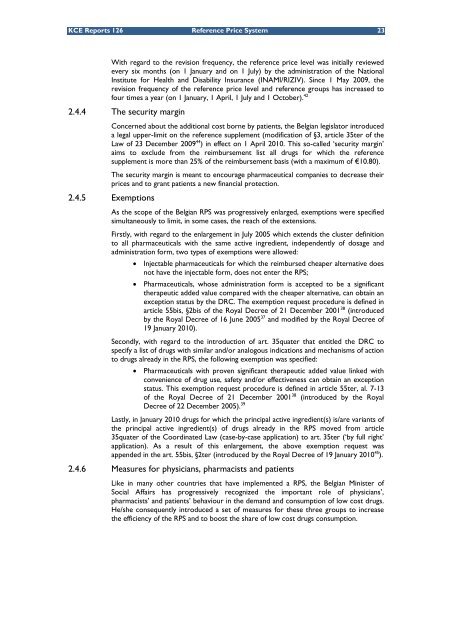The reference price system and socioeconomic differences in ... - KCE
The reference price system and socioeconomic differences in ... - KCE
The reference price system and socioeconomic differences in ... - KCE
You also want an ePaper? Increase the reach of your titles
YUMPU automatically turns print PDFs into web optimized ePapers that Google loves.
<strong>KCE</strong> Reports 126 Reference Price System 23<br />
With regard to the revision frequency, the <strong>reference</strong> <strong>price</strong> level was <strong>in</strong>itially reviewed<br />
every six months (on 1 January <strong>and</strong> on 1 July) by the adm<strong>in</strong>istration of the National<br />
Institute for Health <strong>and</strong> Disability Insurance (INAMI/RIZIV). S<strong>in</strong>ce 1 May 2009, the<br />
revision frequency of the <strong>reference</strong> <strong>price</strong> level <strong>and</strong> <strong>reference</strong> groups has <strong>in</strong>creased to<br />
four times a year (on 1 January, 1 April, 1 July <strong>and</strong> 1 October). 42<br />
2.4.4 <strong>The</strong> security marg<strong>in</strong><br />
Concerned about the additional cost borne by patients, the Belgian legislator <strong>in</strong>troduced<br />
a legal upper-limit on the <strong>reference</strong> supplement (modification of §3, article 35ter of the<br />
Law of 23 December 2009 44 ) <strong>in</strong> effect on 1 April 2010. This so-called ‘security marg<strong>in</strong>’<br />
aims to exclude from the reimbursement list all drugs for which the <strong>reference</strong><br />
supplement is more than 25% of the reimbursement basis (with a maximum of €10.80).<br />
<strong>The</strong> security marg<strong>in</strong> is meant to encourage pharmaceutical companies to decrease their<br />
<strong>price</strong>s <strong>and</strong> to grant patients a new f<strong>in</strong>ancial protection.<br />
2.4.5 Exemptions<br />
As the scope of the Belgian RPS was progressively enlarged, exemptions were specified<br />
simultaneously to limit, <strong>in</strong> some cases, the reach of the extensions.<br />
Firstly, with regard to the enlargement <strong>in</strong> July 2005 which extends the cluster def<strong>in</strong>ition<br />
to all pharmaceuticals with the same active <strong>in</strong>gredient, <strong>in</strong>dependently of dosage <strong>and</strong><br />
adm<strong>in</strong>istration form, two types of exemptions were allowed:<br />
• Injectable pharmaceuticals for which the reimbursed cheaper alternative does<br />
not have the <strong>in</strong>jectable form, does not enter the RPS;<br />
• Pharmaceuticals, whose adm<strong>in</strong>istration form is accepted to be a significant<br />
therapeutic added value compared with the cheaper alternative, can obta<strong>in</strong> an<br />
exception status by the DRC. <strong>The</strong> exemption request procedure is def<strong>in</strong>ed <strong>in</strong><br />
article 55bis, §2bis of the Royal Decree of 21 December 2001 38 (<strong>in</strong>troduced<br />
by the Royal Decree of 16 June 2005 37 <strong>and</strong> modified by the Royal Decree of<br />
19 January 2010).<br />
Secondly, with regard to the <strong>in</strong>troduction of art. 35quater that entitled the DRC to<br />
specify a list of drugs with similar <strong>and</strong>/or analogous <strong>in</strong>dications <strong>and</strong> mechanisms of action<br />
to drugs already <strong>in</strong> the RPS, the follow<strong>in</strong>g exemption was specified:<br />
• Pharmaceuticals with proven significant therapeutic added value l<strong>in</strong>ked with<br />
convenience of drug use, safety <strong>and</strong>/or effectiveness can obta<strong>in</strong> an exception<br />
status. This exemption request procedure is def<strong>in</strong>ed <strong>in</strong> article 55ter, al. 7-13<br />
of the Royal Decree of 21 December 2001 38 (<strong>in</strong>troduced by the Royal<br />
Decree of 22 December 2005). 39<br />
Lastly, <strong>in</strong> January 2010 drugs for which the pr<strong>in</strong>cipal active <strong>in</strong>gredient(s) is/are variants of<br />
the pr<strong>in</strong>cipal active <strong>in</strong>gredient(s) of drugs already <strong>in</strong> the RPS moved from article<br />
35quater of the Coord<strong>in</strong>ated Law (case-by-case application) to art. 35ter (‘by full right’<br />
application). As a result of this enlargement, the above exemption request was<br />
appended <strong>in</strong> the art. 55bis, §2ter (<strong>in</strong>troduced by the Royal Decree of 19 January 2010 45 ).<br />
2.4.6 Measures for physicians, pharmacists <strong>and</strong> patients<br />
Like <strong>in</strong> many other countries that have implemented a RPS, the Belgian M<strong>in</strong>ister of<br />
Social Affairs has progressively recognized the important role of physicians’,<br />
pharmacists’ <strong>and</strong> patients’ behaviour <strong>in</strong> the dem<strong>and</strong> <strong>and</strong> consumption of low cost drugs.<br />
He/she consequently <strong>in</strong>troduced a set of measures for these three groups to <strong>in</strong>crease<br />
the efficiency of the RPS <strong>and</strong> to boost the share of low cost drugs consumption.
















